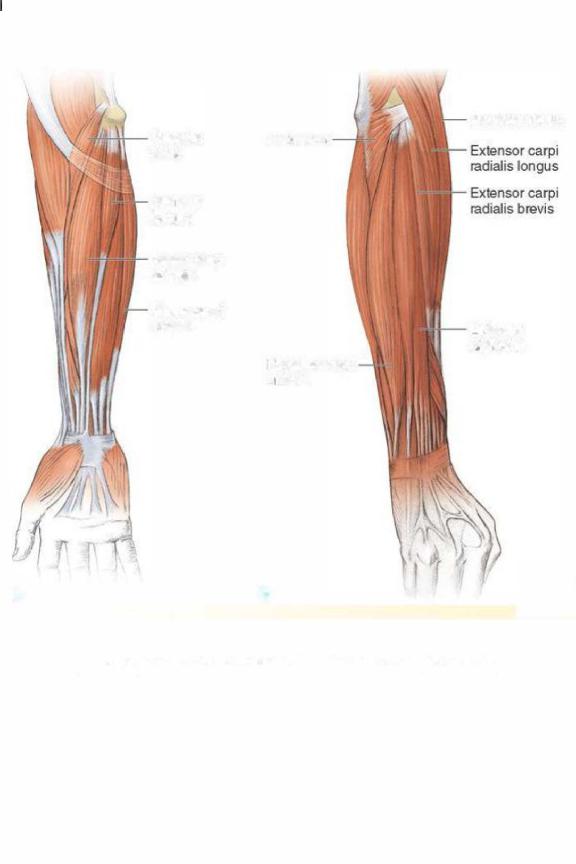
McLeod - Swimming Anatomy - 2010
.pdf
The lower arm, typically called the forearm (figure 2.1, a-b), is supported by the radius and ulna. These three bones are the major attachment sites and levers upon which the muscles of the arm and forearm originate and act on. The two primary muscle groups in the arms that are the target of the strengthening exercises in this chapter are the elbow extensors and elbow flexors. Both contribute to the maintenance of proper arm position and propulsion during each of the four competitive strokes.
Figure 2.1 Forearm: {a}front and {b}back.


process of the ulna. The olecranon process forms the tip of the elbow when it is bent to 90 degrees. A much smaller triangular muscle called the anconeus assists the triceps in extending the elbow joint and is important as an elbow stabilizer. The anconeus is intimate with the lateral head of the triceps brachii; sometimes the fibers of the two muscles blend into one another.
The primary elbow flexors are the biceps brachii and the brachialis (figure 2.3). As the name implies, the biceps has two heads, a long and a short, both of which cross the shoulder joint and attach to the scapula. The two heads fuse to form a common tendon that crosses the front of the elbow joint to attach to the radius approximately 1.5 inches (4 cm) past the elbow. Besides being an elbow flexor, the biceps brachii contributes to the forearm movement of supination, which is the position when the palm is facing up. Your hands would be in this position to carry a bowl of soup. The brachialis lies beneath the biceps brachii and arises at the midpoint of the humerus. It attaches to the ulna just after it passes anteriorly to (in front of) the elbow joint. A smaller muscle that at times contributes to elbow flexion is the brachioradialis. This muscle arises from the lateral aspect of the humerus just above the elbow and travels along the outer part of the forearm to attach to the radius just above the wrist joint.
Despite difference in stroke mechanics, freestyle, butterfly, and backstroke have similar activation patterns of the elbow flexors and extensors during the pull phase. As the swimmer progresses through the catch, the elbow moves from full extension to a position of 30 to 90 degrees of elbow flexion at midpull, depending on the stroke and the swimmer's mechanics. The primary muscles responsible for generating the change in elbow position and, when necessary, maintaining the elbow in a fixed position of flexion are the biceps brachii and brachialis. After the elbow reaches a point of maximal flexion during the midpull, it progresses into an extended position during the remainder of the pull phase. This action aids in generating propulsive forces and is brought about primarily by active recruitment of the triceps brachii. The degree of the propulsive force generated depends on the point in the pull phase at which the swimmer removes the hand from the water to initiate the recovery phase. In freestyle and



triceps brachii becomes activated to extend the elbow joint, thereby straightening the arm and preparing the swimmer to begin the next pull phase.
As you read through the remainder of the chapter you will see that several of the exercises involve movement at a single joint, the elbow, specifically targeting only the elbow extensors (triceps brachii) or the elbow flexors (biceps brachii and brachialis). These isolation exercises are best placed at the end of your dryland program to avoid fatiguing a single muscle group early in the workout program. A final consideration is that between the two muscle groups, the elbow extensors are more active during the swimming movements. Therefore, you should aim for a 2:1 ratio between exercises that target the extensors and the flexors.
When performing upper-body exercises, be sure to set the shoulder blades for stability before performing the exercise. For any exercise, set the core as well. See the sidebar below for instructions about how to do this.
Setting the Shoulder Blades and the Core
Setting the shoulder blades:When performing upper extremity exercises, particularly those that target the shoulder joint, you should set the shoulder blades into a stable position. The setting movement involves pinching the shoulder blades backward and downward, as if you were trying to put your shoulder blades in the back pockets of your pants. In the process of setting the shoulder blades, avoid shrugging the shoulders upward because this action shifts the focus of the exercise from the lower fibers of the trapezius muscle to the upper fibers, which are typically already overdeveloped in most swimmers.
Setting the core:Before performing any exercise you should make a conscious effort to set the core. By setting the core you establish a foundation of support upon which the exercising muscles are able to exert their forces. You should also stabilize the low back, reducing the risk of injury. Setting the core involves simultaneously contracting the abdominal, low back, and gluteal muscles as if they are a

corset that encircles the abdominal region. See chapter 5, page 87, for more information about setting the core.


Triceps

Execution
1 . Stand facing a pulley machine with a high cable attachment. Grasp the handlebar at chest level using an overhand grip so that your hands are slightly less than shoulder-width apart.
2.Holding your elbows tight at your sides, extend the forearms until the elbows are almost locked.
3.Slowly lower the weight stack until it is 1 inch (2.5 cm) above the resting stack and your hands are back to the start position.
